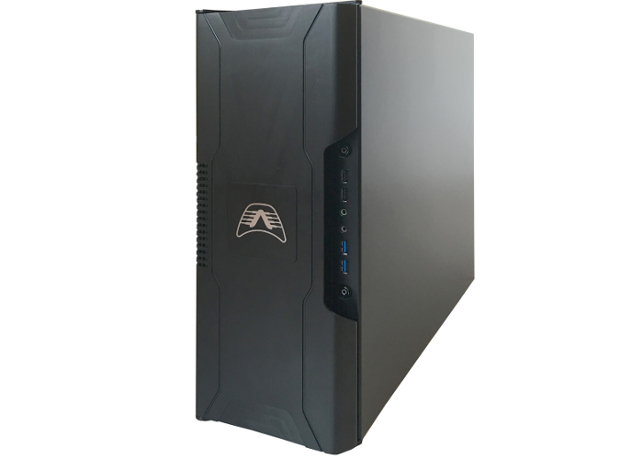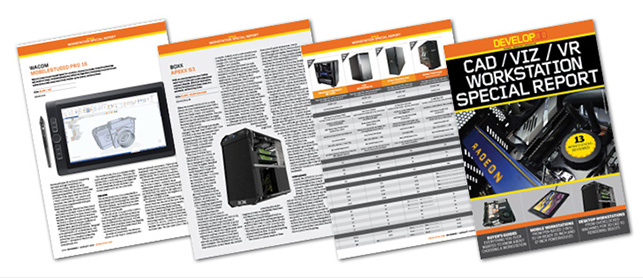Armari Magnetar – With a clock speed of 3.7GHz the Magnetar R80 delivers the goods in single threaded workflows
The phrase custom workstation manufacturer means different things to different people. There are many firms that simply take off-the-shelf PC components, throw in a professional graphics card and call it a workstation. But there are very few that take customisation to the level that Herts-based Armari does.

Armari is well known for designing its own custom chassis — the slimline VR-focused Armari Magnetar V25 that we reviewed in 2017, for example, features a dedicated pocket for the HTC Vive link box. But you may not know that the company goes even deeper into customisation, making bespoke components for its workstations such as PCIe riser boards, heat sinks and PSU cable looms.
In its brand new Armari Magnetar R80 workstation it is looking to get the most out of two power-hungry Xeon Scalable CPUs by letting them run at full frequency when all cores are being used. Liquid cooling is the obvious answer but while there are many off the shelf liquid coolers for consumer CPUs, when it comes to the new Xeon they simply don’t exist, as the volumes are not there. As a result, Armari is developing its own custom liquid cooling system so the CPUs can run at turbo speed on all cores, rather than just the usual one or two.
Unfortunately, the custom cooling solution is still being manufactured, so Armari sent in a pre-production machine with air cooling instead. This means that instead of the two Intel Xeon Gold 6154 processors running all of their 18 cores at 3.70GHz (which Armari says it will achieve once the custom cooling system is ready), clock speeds on this air-cooled system will be a touch slower. But not that much slower. On test, it managed to maintain around 3.5GHz even after we had been rendering a complex KeyShot scene for over an hour.
Rendering performance is virtually identical to the dual 32-core AMD Epyc-based Boston workstation. The Armari Magnetar R80 completed the V-Ray benchmark in 21 seconds and our KeyShot test render in 94 seconds.
However, because it attains this level of performance with fewer CPU cores running at a higher frequency, it beats the Boston machine hands-down in a single threaded race. With a single core clocked at 3.70GHz, it was 32% faster in our SolidWorks IGES export test.
Armari Magnetar – product specifications
■ 2 x Intel Xeon Gold 6154 (3.0GHz, 3.7GHz Turbo) (18 cores, 36 threads)
■ 192GB (12 x 16GB) DDR4-2666 ECC Registered
■ AMD Radeon Pro WX 9100 (16GB) (17.Q4 driver)
■ 480GB Intel Optane 900P NVMe SSD + 4TB Western Digital Gold SATA-6Gb HDD
■ Supermicro X11DAi-N
■ Microsoft Windows 10 Pro
■ 1 year on-site maintenance contract (2 and 3 year options available)
CPU benchmarks (single threaded) – Seconds (smaller is better)
SolidWorks 2015 IGES export: 116
CPU benchmarks (multi-threaded) – Seconds (smaller is better)
Luxion KeyShot 6.1 render test:94
V-Ray CPU rendering benchmark (CPU): 142
GPU compute benchmark – Seconds (smaller is better)
V-Ray render benchmark (GPU): 21
3D graphics benchmarks (3D CAD) – Score (bigger is better)
SPECapc for SolidWorks 2015 (shaded + edges): 4.97
SPECapc for SolidWorks 2015 (RealView + shadows): 8.78
SPECapc for SolidWorks (RealView + shadows + AO): 25.42
SPECapc for PTC Creo 3.0 (shaded + edges): N/A
SPECapc for PTC Creo 3.0 (reflection): N/A
3D graphics benchmarks (design viz) – Frames Per Second (FPS) (bigger is better)
LumenRT (hotel model) (FPS): 14 (17.Q4 driver) 51 (17.Q4.1 driver)
LumenRT (roundabout model): 10 (17.Q4 driver) 26 (17.Q4.1 driver)
Autodesk LIVE (Villa Enhanced model): 71 (17.Q4 driver) 128 (17.Q4.1 driver)
Autodesk VRED Professional (AA off): 60
Autodesk VRED Professional (AA medium): 26
Autodesk VRED Professional (AA ultra high ): 11
3D graphics benchmarks (VR) – Frames Per Second (FPS) (bigger is better)
VR Mark (Orange): 138.16 (17.Q4 driver) 212.6 (17.Q4.1 driver)
VR Mark (Blue): 40.24 (17.Q4 driver) 41.34 (17.Q4.1 driver)
VR Mark (Cyan): 147.72 (17.Q4 driver) 148.39 (17.Q4.1 driver)







